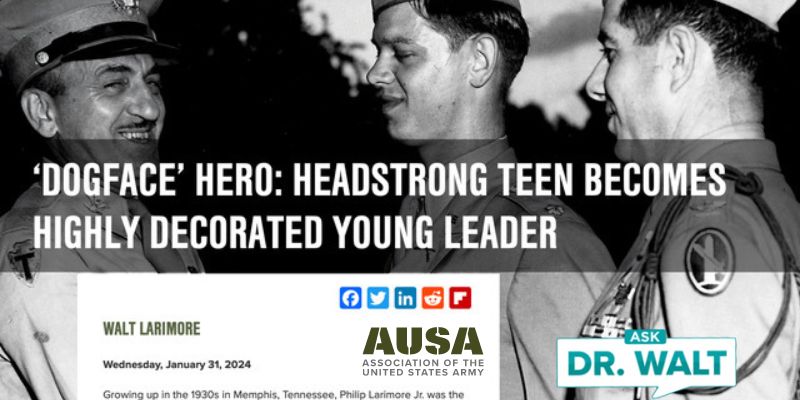
March 25, 1944 – Fate of Anzio Beachhead rests heavily on the ‘Ducks’
March 25, 2024
‘Dogface’ Hero: Headstrong Teen Becomes Highly Decorated Young Leader (Feb 2024 — ARMY magazine)
March 27, 2024Beginning on 26 March, every two days another company the 30th Infantry was sent to the 3rd Division Rest Center in the heart of the Pine Grove bivouac.[1]

At the rest center, the company was completed reoutfitted with new clothes.
All men got hot showers, went to the movies, and had barber service.
Helmets were repainted and Division patches pointed on the sides. New Division patches were issued each man for his uniform.
The peppy 3rd Division band gave a concert one day and the second day the company was to be at the rest center a small ceremony was held and awards presented to deserving officers and men of the company by Brig. Gen John W. O’Daniel, Division commander.[1]
~~~~~
The units enjoyed a two-day breathing spell at the rest camp which was interrupted by an air attack March 29. … The Division, after its rest moved into the Torre Astura area where it trained intensively for the next two weeks on defense and limited-objective attacks. [2]
~~~~~
To counteract the debilitating effects of static warfare, General Truscott not only conducted a vigorous training program but also endeavored to give his men as much rest and recreation as possible when they were out of the line.
Owing to the open nature of most of the beachhead terrain, troops in forward areas usually stayed underground during the day; at night combat patrols probed deep into the enemy lines, and occasionally a company or battalion launched an attack to take prisoners or capture or destroy a strategic group of buildings. Recreation and training facilities were limited by the lack of a safe rear area.
The 1st Armored Division built two underground theaters, each capable of holding over two hundred men. Each division set up small recreation and bath units; at the latter, the men could obtain a complete change of clothing.
On the coast below Nettuno the 3d Division established a large rest camp where men could combine training with opportunities for swimming, going to the movies, and writing letters.
Troops at the beachhead were given priority on mail, Post Exchange supplies, and recreation equipment. The quality of their food also improved. During February rear-area as well as front-line troops lived almost exclusively on C and K rations; by March calmer seas and lessened enemy activity permitted Liberty ships to bring in fresh meat and a high percentage of B rations.
Where organized recreation was impossible, men provided their own amusement.
Horseshoes were in great demand, and volley ball and even baseball games were played close to the fighting front. When enemy shells started coming in, the men ducked for cover and then calmly returned to their games.
A few troops had their own chicken pens; others, less fortunate, dickered with the few remaining Italian farmers for eggs. Patrols for chickens and livestock were as carefully planned as patrols against the enemy.
To help pass the long hours in dugouts men improvised radio sets on which they could listen to the Fifth Army Expeditionary Station and also to Axis propaganda broadcasts. “Sally,” the German radio entertainer, was as well known to them as the “Anzio Express.” They enjoyed her throaty voice and her selections of the latest American popular music; they laughed at her crude propaganda and that of her partner “George,” just as they laughed at the German propaganda leaflets which they collected for souvenirs. German efforts to sow discontent among the Allied troops at the beachhead were singularly onsuccessful. They merely supplied an additional source of entertainment.
It was easy for a replacement arriving at the beachhead on one of the beautiful spring days of April or early May to gain the impression that, despite all the evidence of destruction around the tiny harbor, Anzio was a relatively safe spot. Even the occasional white plume of water, rising as an enemy shell plunged into the calm bay, had an impersonal air about it.
Men worked at the docks unloading LST’s or LCT’s, drivers of DUKW’s churned their vehicles out across the bay toward the Liberty ships outside the harbor, antiaircraft crews lolled by their guns, and a few men swam along the shore below the battered villas. But the apparent unconcern of the men was deceptive.
The terrific tension under which they had lived during the critical days of February had eased somewhat, but some measure of it was still there. The next shell to whistle over the beachhead might well land in the hold of a ship or obliterate a truck driving through the streets of Anzio or Nettuno.
At dusk the feeling of tension increased; men around the harbor kept an eye on the end of the jetty, where the raising of a flag gave warning of another air attack.
Although the enemy abandoned daylight raids after the costly attacks of February, anywhere from one to half a dozen attacks were made every night, and the enemy shelling, sporadic during daylight hours, substantially increased after dark, One night at Anzio dispelled all illusions of security.
The battle of the beachhead remained a grim and deadly struggle to the end.[3]
~~~~~
[1] Prohme, 149.
[2] Taggart, 142.
[3] The Breakthrough. https://history.army.mil/books/wwii/anziobeach/anzio-break.html
In case you haven’t read or listened to Dad’s book, you can learn more or order it here.
© Copyright WLL, INC. 2024.



